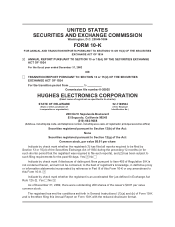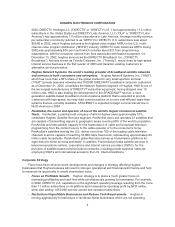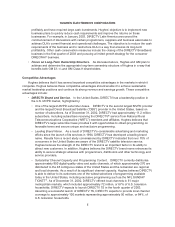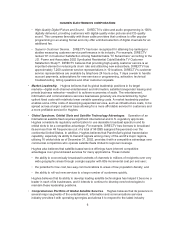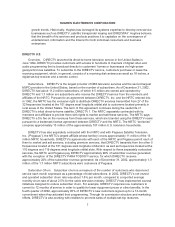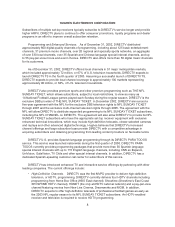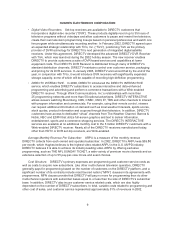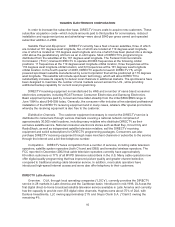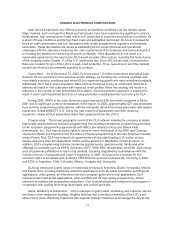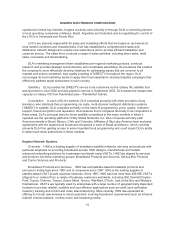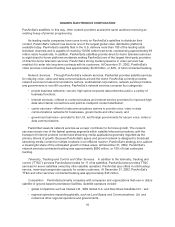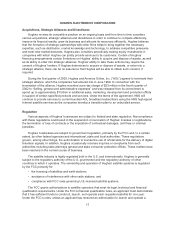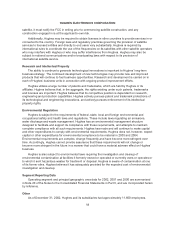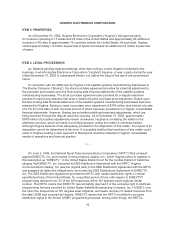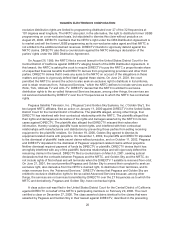DIRECTV 2002 Annual Report Download - page 20
Download and view the complete annual report
Please find page 20 of the 2002 DIRECTV annual report below. You can navigate through the pages in the report by either clicking on the pages listed below, or by using the keyword search tool below to find specific information within the annual report.HUGHES ELECTRONICS CORPORATION
In order to increase the subscriber base, DIRECTV incurs costs to acquire new customers. These
subscriber acquisition costs—which include amounts paid to third parties for commissions, reduced
installation and equipment prices and advertising—were about $540 per gross owned and operated
subscriber addition in 2002.
Satellite Fleet and Equipment. DIRECTV currently has a fleet of seven satellites, three of which
are located at 101 degrees west longitude, two of which are located at 119 degrees west longitude,
one of which is located at 110 degrees west longitude and one of which has been placed into a storage
orbit above the geostationary orbit arc as an in-orbit spare. Most of DIRECTV’s programming is
distributed from the satellites at the 101 degrees west longitude. The Federal Communications
Commission (“FCC”) licensed DIRECTV to operate 46 DBS frequencies at the following orbital
positions: 11 frequencies at the 119 degrees west longitude orbital location, three frequencies at the
110 degrees west longitude orbital location, and 32 frequencies at the 101 degrees west longitude
orbital location. In the fourth quarter of 2003, DIRECTV expects to launch DIRECTV 7S, a high
powered spot-beam satellite manufactured by Loral Corporation that will be positioned at 119 degrees
west longitude. This satellite will include spot-beam technology, which will allow DIRECTV to
substantially increase its capacity to deliver local channels in additional markets. The spot-beams have
been designed to maximize the number of local markets served across the U.S., while providing
additional backup capability for current local programming.
DIRECTV receiving equipment is manufactured by HNS and a number of name brand consumer
electronics companies, including RCA/Thomson Consumer Electronics and Samsung Electronics.
Basic equipment prices paid by consumers have fallen steadily from the initial $699-$899 range in
June 1994 to about $49-$99 today. Generally, the consumer offer includes a free standard professional
installation of the DIRECTV receiving equipment and in many cases, retailers offer special promotions
whereby the receiving equipment is also free to the customer.
Distribution Channels. The customer equipment necessary to receive the DIRECTV service is
distributed to consumers through various channels covering a national network comprised of
approximately 30,000 retail locations, including many retailers who distribute DIRECTV as their
exclusive satellite service. National consumer electronics stores such as Best Buy, Circuit City and
RadioShack, as well as independent satellite television retailers, sell the DIRECTV receiving
equipment and solicit subscriptions for DIRECTV programming packages. Consumers can also
purchase DIRECTV receiving equipment through mass merchant channels or subscribe to the service
through the Internet and a toll-free telephone number.
Competition. DIRECTV faces competition from a number of services, including cable television
operators, satellite system operators (both C-band and DBS) and terrestrial wireless operators. The
FCC reported in December 2002 that cable television operators currently have approximately
69 million customers or 77% of all MVPD television subscribers in the U.S. Many cable operators now
offer digital-quality programming that has improved picture quality and greater channel selection
compared to traditional analog cable television service. In addition, most cable operators have
introduced high-speed Internet access and some also offer telephony to their customers.
DIRECTV Latin America
Overview. DLA, through local operating companies (“LOC’s”), currently provides the DIRECTV
service in 28 markets in Latin America and the Caribbean basin. Introduced in mid-1996, DLA was the
first digital direct-to-home broadcast satellite television service available in Latin America and currently
has the capacity to provide over 355 digital video channels. Hughes owns about 75% of DLA, with
Darlene Investments, LLC owning approximately 21% and Grupo Clarín S.A. (“Clarin”) owning the
remaining 4%.
10



